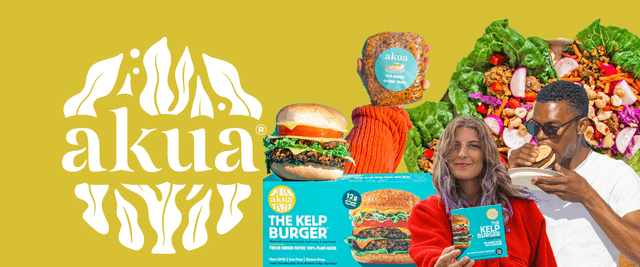Colin Nagy | December 4, 2020
Why is this interesting? - The Kelp Edition
On the ocean, food, and sustainable food
Recommended Products

A kelp-based burger made in Maine with a blend of fresh ingredients including kelp sourced from ocean farms in Maine, crimini mushrooms, pea protein, black beans, quinoa, crushed tomatoes, and superfoods.
Colin here. I ate a kelp burger for dinner last night and I loved it.
To back up a bit, a longtime friend of mine has been working on a kelp-based food company, Akua. She started out making kelp jerky, attracted by both the nutritional and ecological benefits. The initial iteration found favor, landing a thumbs up from Richard Branson and other interesting people around the world. Now she’s set her sights on the protein that can take the place of meats but isn’t the Impossible Foods/Beyond Burger equation. In doing so she created some interesting white space where I didn’t think there was any in the market.
I received the patties in a futuristic silver container with simple directions: throw in a skillet, cook for 7.5 minutes (from frozen), and eat. I was: bracing for a typical vegan style patty: good for you, but not pleasant to the palette. But I was pleasantly surprised. The exterior had a nice crispness and the patty had the satisfying umami flavor. With a bit of hot sauce (which I generally put on most things), I was completely sold.
The brand is trying to run at being a more natural version of some other meat substitute innovations on the market (covered in a previous Meatless Edition). The trouble with the Beyond Burgers and Impossibles of the world (which I do like and eat), is that the science and flavor alchemy that goes into making them palatable is a lot of work. And the level of processing doesn’t mean these new forms are as healthy as they may seem.
The kelp-based burgers have a fairly straightforward ingredient list. They describe it as: “...made in Maine with love - not in a lab - with a blend of fresh ingredients including kelp sourced from our ocean farms in Maine, crimini mushrooms, pea protein, black beans, quinoa, crushed tomatoes, and superfoods. Like a salad, but way better.”
Why is this interesting?
The fact that a kelp burger was delicious is interesting enough and warrants a “man bites dog” sort of pop that is always fun to write about. But I was also intrigued to double click on why kelp is actually nutritious and sustainable. Kelp farming is a zero-input crop that requires no fresh water, no fertilizer, no feed, and no arid land to grow, and it also filters carbon and nitrogen from the water. According to Akua, it also “creates new jobs for our coastal communities. We source our sea greens from a network of regenerative ocean farms along the Northeast coast of the USA. The first seaweed we are working with is a varietal of Kelp called Saccharina Latissima.”
I followed a Shape magazine article down the wormhole, a bit:
[Kelp is] very fast-growing, tacking on about 1.5 feet per day, according to the National Park Service. Some species can reach lengths of 150 feet! Basically, if the world of seaweed had a head honcho, kelp would be it.
Due to its size, kelp looks like an underwater tree. But unlike true plants, this aquatic algae doesn't actually have roots. Instead, kelp secures itself to the rocky ocean floor, then grows from there, forming dense clusters called kelp forests. Some species thrive in the northern Pacific Ocean, from Baja California to Japan, while others call the northwest Atlantic home. They also grow along the coast of Chile, Argentina, South Africa, New Zealand, and Australia, according to Oceana. Regardless of the location, kelp forests are amazingly complex—offering food and shelter to thousands of animals. Other types of seaweed don't grow in packed groups, let alone produce actual ecosystems. The sheer size of kelp is also noteworthy; it's a giant compared to other seaweeds.
Akua isn’t alone in the kelp game, there are others making different forms of foods including kelp noodles, and even kelp cubes to drop into a smoothie. For all of the future of food hype with things being grown in Silicon Valley labs, it will be interesting to see if kelp can make the jump from the health food aisle into more mainstream kitchens around the world. I’m sure the 8-minute prep for the burgers from frozen to the plate will certainly help. Try the burgers here, if you’re so inclined. (CJN)
Edith illustration of the day:
WITI contributor Chris E. shared this excellent Edith Zimmerman illustration in our Slack. Sign up for her newsletter Drawing Links. (CJN)
Quick Links:
A great long read on Shopify (CJN)
Towards a cultural history of...plexiglass (CJN)
Speaking of cultural history, this book about the AK-47 by friend of WITI Chris Chivers is an excellent read. (CJN)
Thanks for reading,
Noah (NRB) & Colin (CJN)
Why is this interesting? is a daily email from Noah Brier & Colin Nagy (and friends!) about interesting things. If you’ve enjoyed this edition, please consider forwarding it to a friend. If you’re reading it for the first time, consider subscribing (it’s free!).

